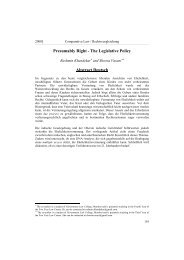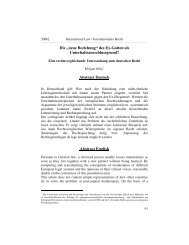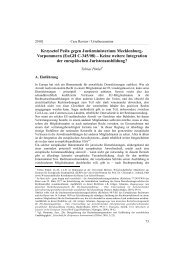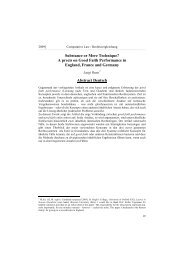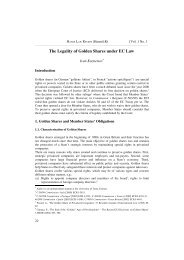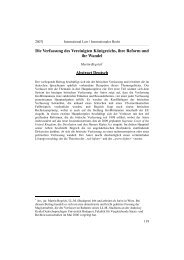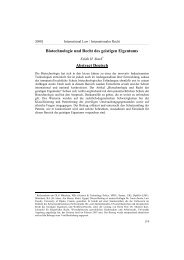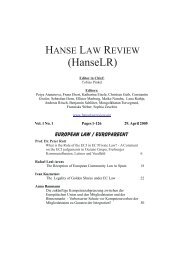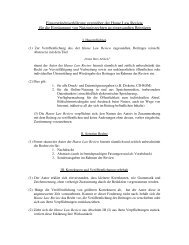The United Nations – a Kantian Dream Come True? - Hanse Law ...
The United Nations – a Kantian Dream Come True? - Hanse Law ...
The United Nations – a Kantian Dream Come True? - Hanse Law ...
Create successful ePaper yourself
Turn your PDF publications into a flip-book with our unique Google optimized e-Paper software.
2009] International <strong>Law</strong> / Internationales Recht<br />
___________________________________________________________________________________________________________________________________________________<br />
IV. <strong>The</strong> <strong>United</strong> <strong>Nations</strong> vs. <strong>Kantian</strong> State Federalism<br />
<strong>The</strong> 200 th anniversary of Perpetual Peace has launched a revival of the discussion on<br />
<strong>Kantian</strong> international political philosophy. 66 Although the beginning of this ‘startling<br />
comeback’ 67 at the same time ended the first fifty years of <strong>United</strong> <strong>Nations</strong> practice,<br />
connections have hardly ever been drawn and comparisons have seldom been attempted. 68<br />
<strong>The</strong> following part intends to challenge this indifference towards a comparative inquiry and<br />
will examine analogies and differences of the <strong>United</strong> <strong>Nations</strong> Organisation and <strong>Kantian</strong><br />
state federalism in respect of their respective goals, the characteristics of their members,<br />
their organisational structure and their competences.<br />
1. Objectives<br />
a) Global Peace <strong>–</strong> the Common Goal<br />
Surprisingly, Perpetual Peace, although similar to contemporary peace treaties in<br />
composition and form, contains no preamble setting out the intentions of the contracting<br />
parties. Systematic considerations and the title of the philosophical sketch, however, leave<br />
little doubt about the goal of its drafter: a plan for perpetual peace. While only a footnote in<br />
Perpetual Peace alludes that it is the ‘state of war […] which it is precisely the aim to<br />
become free of here’, 69 the later work <strong>The</strong> Metaphysics of Morals names perpetual peace<br />
‘the supreme political good’ 70 and states in clear terms that ‘this task of establishing a<br />
universal and lasting peace is not just a part of the theory of right within the limits of pure<br />
reason, but its entire ultimate purpose’. 71 As a part of the <strong>Kantian</strong> doctrine of rights<br />
66 For recent publications in relation to the anniversary see Geismann, Georg, ‘Nachlese zum Jahr des ‘ewigen<br />
Friedens’, [1996] 3 Logos, 317 and Lorz, ‘Die dauerhafte Aktualität des Ewigen Friedens <strong>–</strong> Neuere Entwicklungen<br />
zur Interpretation der Friedensschrift Kants’, both with further references; See also Bialas, Volker and Haessler,<br />
Hans-Jürgen (eds), 200 Jahre Kants Entwurf ‘Zum ewigen Frieden’ (Koenigshausen & Neumann, Würzburg,<br />
1996); Habermas, Jürgen, ‘Kant's Idea of Perpetual Peace With the Benefit of Two Hundred Years' Hindsight’, in<br />
Bohman, J. and Lutz-Bachmann, Mattias (eds), Perpetual Peace <strong>–</strong> Essays on Kant’s Cosmopolitan Ideal (MIT<br />
Press, London, 1997), 113; Klenner, ‘Kants Entwurf ‘Zum ewigen Frieden’ <strong>–</strong> Illusion oder Utopie?’; Schmidt,<br />
Hajo, ‘Ein bedenkenswertes Jubiläum - Kants Traktat “Zum ewigen Frieden” (1795)’, in Birckenbach, M., Jäger,<br />
U. and Wellmann, C. (eds), Jahrbuch Frieden 1995 (Beck, München, 1995), 17; Lutz-Bachmann, Mattias and<br />
Bohman, James (eds), Frieden durch Recht. Kants Friedensidee und das Problem einer neuen Weltordnung<br />
(Suhrkamp, Frankfurt am Main, 1996); Laberge, Pierre, Lafrance, Guy and Dumas, Denis (eds), L’Année 1795:<br />
Kant, Essai sur la Paix (J. Vrin, Paris, 1997).<br />
67 Cavallar, Georg, ‘<strong>Kantian</strong> perspectives on democratic peace: alternatives to Doyle’, [2001] 27 RIS 229, and<br />
Galston, William A., ‘What is living and what is dead in Kant’s Practical Philosophy?’, in Beiner, R. and Booth,<br />
W.J. (eds), Kant & Political Philosophy <strong>–</strong> <strong>The</strong> Contemporary Legacy (Yale University Press, New Haven, 1993),<br />
207.<br />
68 <strong>The</strong> most comprehensive study on the subject is Höffe, ‘Ausblick: Die Vereinten Nationen im Lichte Kants’.<br />
From an earlier stage see also Friedrich, [1947] 9 <strong>The</strong> Journal of Politics 10. <strong>The</strong> subject is also touched upon by<br />
Lutz-Bachmann, 59; Laberge, passim and Schwarz, Wolfgang, ‘Kant’s Philosophy of <strong>Law</strong> ant International<br />
Peace’, [1962] 23 Philosophy and Phenomenological Research 71, 76 ff. and Capps, Patrick, ‘<strong>The</strong> <strong>Kantian</strong> Project<br />
in Modern International <strong>The</strong>ory’, [2001] 12 EJIL 1003, 1004. Unfortunately no legal scholar has tackled the<br />
subject so far in a more comprehensive article.<br />
69 Kant, Immanuel, ‘Zum ewigen Frieden’, in Klemme, H. (ed), Immanuel Kant <strong>–</strong> Über den Gemeinspruch/Zum<br />
ewigen Frieden (Meiner, Hamburg, 1992), 349 in fn.*. See Kant, ‘Perpetual Peace’, 99 where Nisbet translates<br />
somewhat more freely ‘in a state of nature, there would be a risk of war, which it is precisely the aim of the above<br />
articles to prevent.’<br />
70 Kant, ‘<strong>The</strong> Metaphysics of Morals’, 175.<br />
71 Ibid., 174.<br />
57



